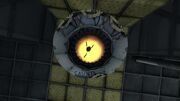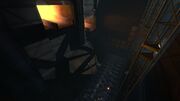| This article is within the scope of the Portal Project, a collaborative effort to improve articles related to Portal and Portal 2. See the project page for more details about the article status. |
| To illustrate the article add one or more relevant images or upload them from canonical / official sources. For more instructions visit Half-Life Wiki:Images. |
- "Did you just stuff that Aperture Science Thing We Don't Know What It Does into an Aperture Science Emergency Intelligence Incinerator?"
- ―GLaDOS[src]
The Aperture Science Emergency Intelligence Incinerator is an equipment incinerator used within the Aperture Science Enrichment Center.
Overview[]
Portal[]
- The Emergency Intelligence Incinerator is first seen in Test Chamber 17 when Chell is required to "euthanize" her Weighted Companion Cube.
- The Emergency Intelligence Incinerator works via a small button pedestal, which opens an aperture over the top of the incinerator (a reference to the Aperture Science logo). The flame symbol and the word "CAUTION" is inscribed around its rim. The incinerator may be related to the Diversity Furnace.
- Another incinerator is featured in GLaDOS' chamber; Chell uses it to destroy all four of GLaDOS' Personality Cores.
- It should be noted that the Intelligence Incinerator is only active when the aperture is open; the flames stop after the aperture closes.
Portal 2[]

The main incineration chamber
- The incinerator in Portal 2 is first seen in GLaDOS' ruined chamber. Shortly after GLaDOS is reawakened, she drops Chell into it in order to retrieve the Dual Portal Device. This is also where it is revealed that the emergency intelligence incinerators lead down to a main incineration chamber, far down in the Aperture Science facilities. Due to the speed at which things seem to be incinerated in Portal, portal technology could be used in the incinerators.


Throwing a personality core into the Emergency Intelligence Incinerator.

The turret grinder meant to incinerate defective turrets
- The Emergency Intelligence Incinerator is seen once again in the game's fifth chapter, within the facility's turret production lines. It is used to incinerate any defective turrets that failed the manufacturing process. When Chell switches the Master Turret with a defective one, functioning turrets are thrown into the Incinerator instead. It is later revealed that this incinerator leads to a grinder under the neurotoxin generator control room. This is referenced by Wheatley: “There's our handiwork. Shouldn't laugh, really. They do feel pain. Of a sort. All simulated. But real enough for them I suppose.” It is unknown whether or not this is related to the Turret Redemption Lines.
- In the game, the Fact Sphere reports (correctly) that "tungsten has the highest melting point of any metal at 3,410 degrees Celsius." This calls into question what kind of material Aperture technology is made of, or how long they can survive 4000 Kelvin (3727 degrees Celsius).
Gallery[]
List of appearances[]
- Portal (First appearance)
- Portal: Still Alive (Non-canonical appearance)
- PotatoFoolsDay ARG
- Portal 2
